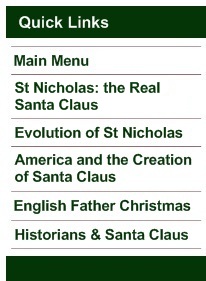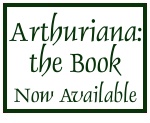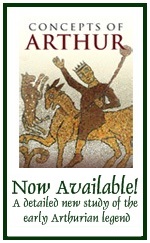
 |
 |
The English Father Christmas: A Separate Origin Introduction The English Father Christmas seems to have had an entirely separate origin from Sinterklaas, being a personification of Christmas and a Yule-tide visitor - not a gift-giver - rather than a version of St Nicholas. The earliest reference to him comes from the mid-fifteenth century, when a Sir Christėmas appears in a carol, although most discussions start with Ben Johnson's early seventeenth-century old or Captaine Christmas. Whilst strenuous efforts were made by the puritans of the seventeenth century to do away with this character, they did not succeed. In the nineteenth century Father Christmas benefitted from the general Victorian revival of Christmas and can be found in, for example, Dickens' Christmas Carol. However, from the 1870s onwards Father Christmas became increasingly like the American Santa Claus, both in terms of his actions - he started giving gifts - and his appearance, with the result that two are nowadays virtually inter-changeable. Guide to Online Resources
The Reformation and Father Christmas gives a brief but informative account of Father Christmas, including some speculations on possible pagan origins and details of the seventeenth-century puritan repression of Christmas. A similar tack is also taken in Christmas Customs From England, and the Wikipedia Father Christmas page likewise offers a relatively detailed discussion of his early appearances and significance. Ben Johnson's early seventeenth-century play, Christmas, His Masque, is also available online (both in plain text and as an Oxford Scholarly Edition), as is Josiah King's 1686 The Examination and Tryal of Father Christmas.
A
detailed discussion of the general development of the English Christmas
from the seventeenth century through to the Victorian era is available
in Charlotte Austin's The Celebration
of Christmastide in England from the Civil Wars to its
Victorian Transformation. An Excerpt from The Oxford Dictionary of English Folklore on 'Father Christmas' From J. Simpson and S. Roud, The Oxford Dictionary of English Folklore (Oxford, 2001), pp. 119-20 The earliest evidence for a personified ‘Christmas’ is a carol attributed to Richard Smart, Rector of Plymtree (Devon) from 1435 to 1477; it is a sung dialogue between someone representing ‘Sir Christmas’ and a group who welcome him, in a way suggestive of a visiting custom:
Sir Christmas then gives news of Christ’s birth, and urges his hearers to drink:
There were Yule ridings in York (banned in 1572 for unruliness), where a man impersonating Yule carried cakes and meat through the street. In Tudor and Stuart times, ‘Lords of Misrule’ called ‘Captain Christmas’, ‘The Christmas Lord’, or ‘Prince Christmas’ organized and presided over the season’s feasting and entertainment in aristocratic houses, colleges, and Inns of Court. A personified ‘Christmas’ appears in Ben Jonson’s court entertainment Christmas his Masque (1616), together with his sons: Misrule, Carol, Mince Pie, Gambol, Post-and-Pan, New Years Gift, Mumming, Wassail, and Baby Cake. He protests against an attempt to exclude him:
The need to defend seasonal revelry against Puritan accusations of Popery became more urgent some decades later. Pamphleteers continued the device of personifying Christmas, as in The Examination and Tryall of Old Father Christmas (1658) and An Hue and Cry after Christmas (1645). Echoing this tradition, Father Christmas acts as a presenter in many versions of the mumming play, with such opening lines as:
The Victorian revival of Christmas involved Father Christmas too, as the emblem of ‘good cheer’, but at first his physical appearance was variable. He had always been imagined as old and bearded (in a masque by Thomas Nabbes (1638) he is ‘an old reverend gentleman in a furred gown and cap’), but pictures in the London Illustrated News in the 1840s show him variously as a reveller in Elizabethan costume grasping a tankard, a wild holly crowned giant pouring wine, or a lean figure striding along carrying a wassail bowl and a log. One famous image was John Leech’s illustration for Dickens’s Christmas Carol (1843), where the gigantic Ghost of Christmas Present, sitting among piled-up food and drink, wears exactly the kind of fur-trimmed loose gown of the modern Father Christmas -- except that it is green, matching his holly wreath. Towards the end of the 1870s, he developed a new role as a present-bringer for children, in imitation either of European St Nicholas customs, or of the American Santa Claus, or both. By 1883, a French visitor mentions, as a matter of common knowledge, that he comes down chimneys and puts toys and sweets in stockings. In view of the German influence on the British Christmas, it may be significant that in Southern Germany the saint was accompanied by a gnome-like servant, usually dressed in a red, brown, or green hooded garment, usually carrying a small fir tree and a bag of toys. Father Christmas’s costume became more standardized: it was almost always predominantly red, though Victorian Christmas cards do occasionally show him in blue, green, or brown; in outdoor scenes he often wore a heavy, hooded knee-length coat and fur boots; he carried holly, but the holly crown became rarer. Nowadays Father Christmas is almost always associated with children’s presents rather than adult feasting. His authentic dress is a loose, hooded red gown edged with white; however, he now often wears a red belted jacket and tasselled floppy cap imitated from Santa Claus, and has acquired Santa’s reindeer sledge and nocturnal habits. Elsewhere in this work (p. 314) it is stated that Santa Claus and the tradition of his gift-giving to children was first noted in England in 1879, and nineteenth-century folklorists were at first very puzzled by it as they knew of no similar English tradition, nor who Santa Claus was: see The Historians and Santa Claus. *
* * * *
Copyright ©
2004, 2015 Caitlin R. Green. All Rights Reserved. To cite articles or pages
from this website, use a service such as WebCite or
alternatively see one of the following style
citation guides. Comments and queries via email to Caitlin R. Green |
 
|